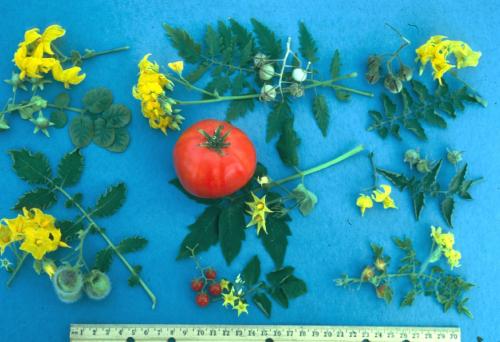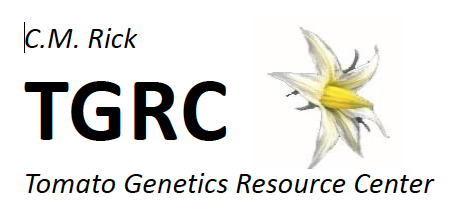
The following species identification key is a revision of the one formulated by Rick et al. (1990) Tomato Genetics Cooperative Report 40: 31. This key has been expanded to include subspecific taxa, as well as four tomato-allied Solanum species. Solanum species names are based on Peralta et al. (2005, 2008).
1. Interior of ripe fruit red; seeds 1.5 mm or longer.
1.1. Fruit diameter more than 1.5 cm; leaf margins generally serrate.
1.1.1. Fruit diameter 3 cm or larger, 2-to-many loculed. ...Solanum lycopersicum (formerly Lycopersicon esculentum)
1.1.2. Fruit diameter 1.5-2.5 cm, 2-loculed. ...S. lycopersicum var. cerasiforme (L. esculentum var. cerasiforme)
1.2. Fruit diameter less than 1.5 cm, usually ca. 1 cm; leaf margins generally undulate or entire. ...S. pimpinellifolium (L. pimpinellifolium)
2. Interior of fruit yellow or orange; seeds 1.0 mm or shorter ...S. cheesmaniae (L. cheesmanii)
2.1. Leaves highly subdivided; internodes short, densely pubescent; flowers with large accrescent calyx. ...S. galapagense (L. cheesmanii f. minor)
3. Interior of ripe fruit green or whitish; seeds of varying sizes.
3.1. Sympodia with 2 leaves.
3.1.1. Inflorescences with small or no bracts.
3.1.1.1. Flowers small (corolla diameter 1.5 cm or less); seeds 1 mm or shorter. ...S. neorickii (L. parviflorum)
3.1.1.2. Flowers larger (corolla diameter 2 cm or more); seeds 1.5 mm or longer. ...S. chmielewskii (L. chmielewskii)
3.1.2. Inflorescences with large bracts.
3.1.2.1. Anthers attached in a tube; dehiscent by longitudinal slits.
3.1.2.1.1. Plants erect; peduncle longer than 15 cm; flowers congested; anther tube straight. ...S. chilense (L. chilense)
3.1.2.1.2. Plants spreading; peduncle shorter than 15 cm; flowers more loosely arrayed.
3.1.2.1.2.1 Inflorescences mostly unbranched; short pubescence; mostly straight anthers. ...S. arcanum (L. peruvianum, L. peruvianum var. humifusum)
3.1.2.1.2.2 Bifurcate inflorescences; short soft white pubescence; curved anthers; well developed inflorescence bracts. ...S. peruvianum (L. peruvianum)
3.1.2.1.2.3 Bifurcate or simple inflorescences; long, glandular pubescence; curved anthers. ...S. corneliomulleri (L. peruvianum, L. peruvianum f. glandulosum)
3.1.2.1.2.4 Bifurcate inflorescences; very little pubescence; straight or sometimes curved anthers; long peduncle. ... S. huaylasense (L. peruvianum)
3.1.2.2. Anthers free, dehiscent through terminal pores; corollas slightly zygomorphic; pedicel articulation usually basal. ...S. pennellii (L. pennellii)
3.1.2.2.1. Leaves and stems puberulous, shiny. ... S. pennellii (L. pennellii var. puberulum)
3.2. Sympodia with 3 leaves. ...S. habrochaites (L. hirsutum)
3.2.1. Leaves and stems nearly free of hairs; stems slender, darkly pigmented with anthocyanins. ...S. habrochaites (L. hirsutum f. glabratum)
3.3. Sympodia with more than 3 leaves.
3.3.1. Anthers white to cream-colored; leaf margins dissected.
3.3.1.1. Leaves and stems pubescent; fruit purplish green, ‹ 1 cm diameter, ripen to hard papery texture. ...S. lycopersicoides
3.3.1.2. Leaves and stems glabrous, nearly succulent, lacking anthocyanins; fruit yellowish green, usually ›1 cm diameter, ripen to a hard papery texture. ...S. sitiens (S. rickii)
3.3.2. Anthers yellow; leaf margins entire, leaflets elliptic to lanceolate
3.3.2.1. Leaflets relatively broad, scabrous above, generally 2 pairs of lateral leaflets; fruits 2-3 cm diameter. ....S. juglandifolium
3.3.2.2. Leaflets relatively narrow, smooth-velvety above; fruit >2cm diameter. ...S. ochranthum
References:
Peralta, I.E., S. Knapp, D.M. Spooner (2005) New Species of Wild Tomatoes (Solanum Section Lycopersicon: Solanaceae) from Northern Peru. Systematic Bot. 30: 424-434.
Peralta, I.E., D.M. Spooner, and S. Knapp (2008) Taxonomy of wild tomatoes and their relatives (Solanum sect. Lycopersicoides, sect. Juglandifolia, sect. Lycopersicon; Solanaceae). Systematic Botany Monographs 84.
